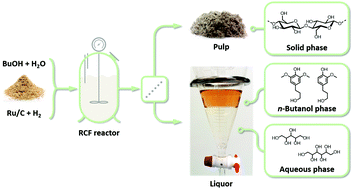当前位置:
X-MOL 学术
›
Green Chem.
›
论文详情
Our official English website, www.x-mol.net, welcomes your
feedback! (Note: you will need to create a separate account there.)
Catalytic lignocellulose biorefining in n-butanol/water: a one-pot approach toward phenolics, polyols, and cellulose
Green Chemistry ( IF 9.3 ) Pub Date : 2018-08-01 , DOI: 10.1039/c8gc01031e T. Renders 1, 2, 3, 4 , E. Cooreman 1, 2, 3, 4 , S. Van den Bosch 1, 2, 3, 4 , W. Schutyser 1, 2, 3, 4 , S.-F. Koelewijn 1, 2, 3, 4 , T. Vangeel 1, 2, 3, 4 , A. Deneyer 1, 2, 3, 4 , G. Van den Bossche 1, 2, 3, 4 , C. M. Courtin 2, 3, 4, 5 , B. F. Sels 1, 2, 3, 4
Green Chemistry ( IF 9.3 ) Pub Date : 2018-08-01 , DOI: 10.1039/c8gc01031e T. Renders 1, 2, 3, 4 , E. Cooreman 1, 2, 3, 4 , S. Van den Bosch 1, 2, 3, 4 , W. Schutyser 1, 2, 3, 4 , S.-F. Koelewijn 1, 2, 3, 4 , T. Vangeel 1, 2, 3, 4 , A. Deneyer 1, 2, 3, 4 , G. Van den Bossche 1, 2, 3, 4 , C. M. Courtin 2, 3, 4, 5 , B. F. Sels 1, 2, 3, 4
Affiliation

|
Lignocellulose constitutes an alluring renewable feedstock for the production of bio-based chemicals. In this contribution, we propose a chemocatalytic biorefinery concept that aims to convert lignocellulosic biomass (Eucalyptus sawdust) into (i) lignin-derived (mono)phenolics, (ii) hemicellulose-derived polyols, and (iii) a cellulose pulp. This is achieved by processing biomass in an equivolumetric mixture of n-butanol and water at elevated temperature (200 °C), in the presence of Ru/C and pressurised hydrogen (30 bar). During this one-pot Reductive Catalytic Fractionation (RCF) process, the hot liquor enables the extraction and solvolytic depolymerisation of both lignin and hemicellulose, while the catalyst and reductive environment are essential to hydrogenate reactive intermediates (coniferyl/sinapyl alcohol and sugars) toward stable target products (phenolics and polyols, respectively). After the catalytic reaction, the solid carbohydrate pulp (mainly cellulose) is easily retrieved upon filtration. Phase separation of n-butanol and water occurs upon cooling the liquor (<125 °C), which offers a facile and effective strategy to isolate lignin-derived phenolics (n-butanol phase) from polyols (aqueous phase). The three resulting product streams provide a versatile platform for down-stream conversion, en route to bio-based chemicals. A proof-of-concept experiment using a 2 L batch reactor demonstrates the scalability potential. Furthermore, this contribution highlights that the conversion of each biopolymer is influenced in a different way by reaction parameters like catalyst, hydrogen pressure, temperature, and acidity (HCl). The key challenge is to find suitable conditions that allow (close-to-)optimal valorisation of all constituents.
中文翻译:

正丁醇/水中的催化木质纤维素生物精制:一锅法制取酚醛树脂,多元醇和纤维素
木质纤维素构成用于生产生物基化学品的诱人的可再生原料。在这项贡献中,我们提出了一种化学催化生物精炼概念,旨在将木质纤维素生物质(桉木锯末)转化为(i)木质素衍生的(单)酚醛树脂,(ii)半纤维素衍生的多元醇和(iii)纤维素纸浆。这是通过在Ru / C和加压氢气(30 bar)存在下,在高温(200°C)下在正丁醇和水的等体积混合物中处理生物质来实现的。在此一锅还原催化分馏过程中(RCF)工艺,热液能够对木质素和半纤维素进行萃取和溶剂解聚,而催化剂和还原环境对于将反应性中间体(松柏油基/芥子醇和糖)氢化成稳定的目标产物(分别为酚醛和多元醇)是必不可少的)。催化反应后,固体碳水化合物浆(主要是纤维素)易于过滤回收。冷却液体(<125°C)时,正丁醇和水会发生相分离,这提供了一种简便有效的策略,可将木质素衍生的酚类化合物(正丁醇相)与多元醇(水相)分离。三个得到的产品流提供了一个通用的平台,为下游的转换,途中生物基化学品。使用2 L分批反应器的概念验证实验证明了可扩展性的潜力。此外,这一贡献突出表明,每种生物聚合物的转化率都受到反应参数(例如催化剂,氢气压力,温度和酸度(HCl))的不同影响。关键的挑战是找到合适的条件,以允许(接近)所有成分的最佳增值。
更新日期:2018-10-15
中文翻译:

正丁醇/水中的催化木质纤维素生物精制:一锅法制取酚醛树脂,多元醇和纤维素
木质纤维素构成用于生产生物基化学品的诱人的可再生原料。在这项贡献中,我们提出了一种化学催化生物精炼概念,旨在将木质纤维素生物质(桉木锯末)转化为(i)木质素衍生的(单)酚醛树脂,(ii)半纤维素衍生的多元醇和(iii)纤维素纸浆。这是通过在Ru / C和加压氢气(30 bar)存在下,在高温(200°C)下在正丁醇和水的等体积混合物中处理生物质来实现的。在此一锅还原催化分馏过程中(RCF)工艺,热液能够对木质素和半纤维素进行萃取和溶剂解聚,而催化剂和还原环境对于将反应性中间体(松柏油基/芥子醇和糖)氢化成稳定的目标产物(分别为酚醛和多元醇)是必不可少的)。催化反应后,固体碳水化合物浆(主要是纤维素)易于过滤回收。冷却液体(<125°C)时,正丁醇和水会发生相分离,这提供了一种简便有效的策略,可将木质素衍生的酚类化合物(正丁醇相)与多元醇(水相)分离。三个得到的产品流提供了一个通用的平台,为下游的转换,途中生物基化学品。使用2 L分批反应器的概念验证实验证明了可扩展性的潜力。此外,这一贡献突出表明,每种生物聚合物的转化率都受到反应参数(例如催化剂,氢气压力,温度和酸度(HCl))的不同影响。关键的挑战是找到合适的条件,以允许(接近)所有成分的最佳增值。











































 京公网安备 11010802027423号
京公网安备 11010802027423号